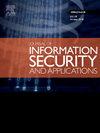Coordinate plane based authentication method for detecting clone node in wireless sensor networks
IF 3.7
2区 计算机科学
Q2 COMPUTER SCIENCE, INFORMATION SYSTEMS
Journal of Information Security and Applications
Pub Date : 2025-07-03
DOI:10.1016/j.jisa.2025.104148
引用次数: 0
Abstract
Nowadays, wireless sensor networks (WSNs) have become a very promising technology for automatic data collection in many applications. Due to the feature of limited resource, WSNs are more vulnerable to certain attacks, such as node clone attacks. An adversary can clone a valid member sensor node and place the new clone node within the group to collect information in the group. The clone node has the same information as the cloned one, and can act as if it were the cloned one to obtain the group key, leading to leakage of group communication data. The current solutions have drawbacks; for instance, schemes based on IDS require additional component support. In this paper, a novel authentication scheme is proposed to address node clone attacks, utilizing a coordinate plane instead of geographical locations. This scheme also possesses additional functionalities, effectively managing node additions and revocations while incorporating collusion attack detection. Through theoretical analysis, the detection rate of our scheme is approximately 99.5%. Experimental simulations demonstrate that the practical detection rate of our scheme is 98.4%, which is lower than the theoretical maximum rate but is higher than that of many recent works and does not rely on additional mechanisms such as trust or hierarchical structures. Furthermore, through multiple rounds of detection, the overall detection rate can be further improved, and collusion attacks can be effectively identified.
基于坐标平面的无线传感器网络克隆节点检测认证方法
目前,无线传感器网络(WSNs)已经成为一种非常有前途的自动数据采集技术。由于资源有限的特点,wsn更容易受到某些攻击,如节点克隆攻击。攻击者可以克隆一个有效的成员传感器节点,并将新的克隆节点放置在组中,以收集组中的信息。克隆节点拥有与克隆节点相同的信息,可以冒充克隆节点获取组密钥,导致组通信数据泄露。目前的解决方案存在缺陷;例如,基于IDS的模式需要额外的组件支持。本文提出了一种新的认证方案,利用坐标平面代替地理位置来解决节点克隆攻击。该方案还具有额外的功能,有效地管理节点的添加和撤销,同时结合了合谋攻击检测。通过理论分析,本方案的检测率约为99.5%。实验仿真表明,该方案的实际检测率为98.4%,低于理论最大值,但高于近期许多研究成果,并且不依赖于信任或层次结构等附加机制。通过多轮检测,进一步提高整体检测率,有效识别合谋攻击。
本文章由计算机程序翻译,如有差异,请以英文原文为准。
求助全文
约1分钟内获得全文
求助全文
来源期刊

Journal of Information Security and Applications
Computer Science-Computer Networks and Communications
CiteScore
10.90
自引率
5.40%
发文量
206
审稿时长
56 days
期刊介绍:
Journal of Information Security and Applications (JISA) focuses on the original research and practice-driven applications with relevance to information security and applications. JISA provides a common linkage between a vibrant scientific and research community and industry professionals by offering a clear view on modern problems and challenges in information security, as well as identifying promising scientific and "best-practice" solutions. JISA issues offer a balance between original research work and innovative industrial approaches by internationally renowned information security experts and researchers.
 求助内容:
求助内容: 应助结果提醒方式:
应助结果提醒方式:


